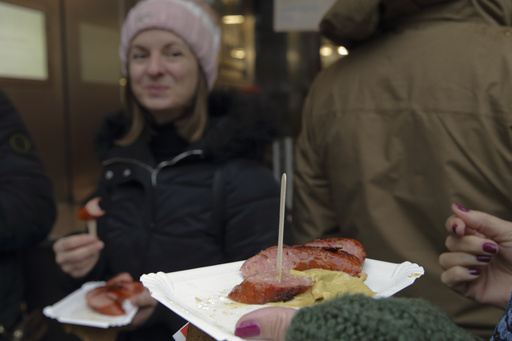
The Würstelstand, a cherished part of local culture, was added this week to the national inventory of intangible cultural heritage maintained by the Austrian commission for UNESCO. This listing places the Würstelstand alongside Vienna’s renowned wine taverns, known as “Heurigen,” which were recognized in 2019, and the city’s unique coffee house culture that earned accolades in 2011.
The Würstelstand has a rich history that spans generations and is celebrated for more than just satisfying cravings for savory foods. These street vendors have long fostered connections between individuals from various social classes and backgrounds, complete with their own unique terminology.
Among the offerings at these stands is the “Haasse,” a coarse boiled sausage, and the “Käsekrainer,” a cheesy smoked sausage that oozes melted cheese, often dubbed “Eitrige” or “suppurating” sausage. There’s also the spicy “Oaschpfeiferl,” a pepperoni, and the “Krokodü,” a tangy gherkin.
“The history of sausage stands in Vienna stretches back a long way,” noted Josef Bitzinger, who operates the Bitzinger Würstelstand adjacent to the Albertina museum and just behind the Vienna State Opera. “Initially, there was just a bucket of hot water where the sausages would sit,” he explained. The first vendors used small carts pulled by dogs or larger ones by horses, and eventually transitioned to using VW buses or tractors for transportation.
This culinary tradition dates back to the era before World War I during the Austro-Hungarian Empire, where former soldiers established mobile eateries to earn a living. The city’s oldest stationary stall, Würstelstand Leo, has been serving delicious sausages since 1928. The establishment gained significance after the regulations allowing fixed stalls were expanded in 1969.
That pivotal year also saw the introduction of a griddle, leading to the creation of the famed Käsekrainer, which has since become a classic dish, according to Bitzinger. “Today, that’s already a classic,” he reiterated.
Vienna’s Mayor, Michael Ludwig, expressed pride in this UNESCO designation, stating, “This honors the tradition, the hospitality, and the diversity of our city.” He emphasized that sausage stands are more than mere eateries; they serve as vibrant gathering places where the essence of life and culture intersect.
Bitzinger emphasized the significance of this recognition, stating, “We have been advocating for this for a long time.” He remarked on the accessibility of this form of gastronomy, highlighting that it allows everyone—from the general director to celebrities during the opera ball, to workers and street cleaners—to share a common space. “That unites people,” he concluded.
